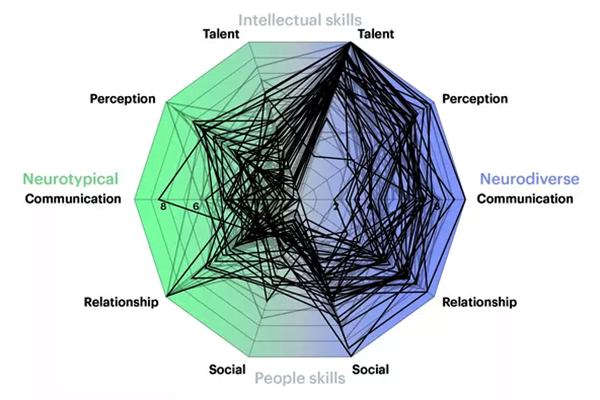Although the Aspie Quiz is not as scientifically backed as some of the other psychometric tests used to assess autism, it’s deeper and more insightful than it may appear at first. I actually think it’s more useful than some of the more popular autism tests such as the AQ, but interpreting your results is not necessarily as straight-forward. After reading this post, you will probably get more out of the Aspie Quiz.
The Aspie Quiz results are multi-faceted, and so there are two things to make sense of:
- What do the Aspie score and the neurotypical score actually mean, and how do they relate?
- What do the subcategories mean?
ND & NT scores
The Aspie Quiz gives two scores rather than one, which can be quite confusing, especially when both scores just about balance each other out. Basically, the Aspie Quiz measures autistic traits on the one hand, and social abilities on the other, which are attributed to neurotypicality.
This also means that if you have greater social skills or an ability to mask your autistic behaviors, you may score higher on the neurotypical side and lower on the autism side. This limitation is not distinct to this test, as camouflaging can influence the results of most of the other psychometric tests.
Most psychometric tests for autism have a threshold score, above which there is a distinct likelihood of autism. The Aspie Quiz does as well, but it’s based on two scores, meaning the ratio is more significant than either individual score.
Basically, if your Aspie score is 35 points greater than your neurotypical score, you are likely autistic. An Aspie score of 120 and a neurotypical score of 132 indicate more neurotypical traits, which means autism is not probable, although not ruled out. As stated, camouflaging can actually camouflage your Aspie score. To test how much you camouflage, take the CAT-Q.
Besides, several psychometric tests need to be done to conclusively indicate or rule out autism. Not all autistic people necessarily score above the threshold on each test.
Domains
The subcategories of the Aspie Quiz are arguably the most interesting part, but this is exactly the part that is largely overlooked, because the categories are not explained.
The Aspie Quiz features 5 domains: talent, perception, communication, relationships, and social. Now, the test is not comprehensive enough to give a real measure of most of these domains. Talent for example is a really broad concept, and the Aspie Quiz wasn’t developed specifically to measure that. Nor is this a test measuring the extent of perceptive abilities—and so forth. When your Aspie score in relationships is high, there is a tendency to interpret that as, “Oh I must be able to relate well to fellow autistic people”. While that is likely true, that is not actually what a high Aspie score in relationships shows.
It’s better to discard everything you think you understand about the five domains of the Aspie Quiz, and just look at what the scores actually correlate with. In the table below, I compiled all the correlations.
Aspie Quiz domains
A table showing the five domains of the Aspie Quiz and what the scores in each domain correlate with.Correlations
To really get a sense of which correlations with the domains we actually commonly see in autism, in the figure below I have superimposed 81 results of autistic people (diagnosed in black, undiagnosed in grey). As you can see, a very distinct pattern emerges.

What is quite funny to me is the peak we see in neurodiverse talent. Because while it does correlate partially with our actual talent (based on special interests and a proclivity to notice details and patterns), what it also strongly correlates with is Asperger syndrome.
And given that this is an autism test, it shouldn’t be surprising that autistic people tend to score high in this domain.
Comments
Let us know what you think!